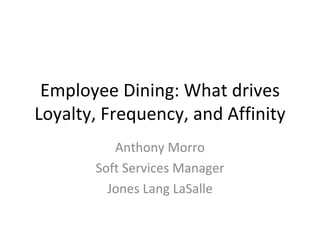Driving Participation Bi
- 1. Employee Dining: What drives Loyalty, Frequency, and Affinity Anthony Morro Soft Services Manager Jones Lang LaSalle
- 2. Participation = Marketshare • Participation is to a B&I Dining Facility as market share is to a major corporation • It is measured by: – Meal Time Transactions/Available Population • It is a key performance indicator that demonstrates the frequency by which customers choose your services/products over the competition • And the competition is there in many shapes and sizes
- 3. What will success look like? • Set target for participation rates – Breakfast – Lunch – Dinner • Targets will be relative to a number of factors – Rural, Urban, Suburban – External Competition • Participation up = Productivity – The ultimate ROI
- 4. ROI Calculation - Incremental • On site saves 20-30 minutes per cafeteria user • Site with 2000 people at 50% lunch time participation = 1000 stay on site daily • 1000 X 20 Minutes = 20, 000 minutes – 20K Minutes X 240 Days = 4.8M minutes/60 – 80,000 hours potentially returned to core business activities • A 5% increase in lunch time participation? – Could add another 8,000 hours or 10% additional hours potentially returned to core business activities
- 5. ROI Calculation - Transformational • A 20% increase (transformational)
- 6. Food • Quality – Fresh, Wholesome, Nutritious – Appearance, Color, Texture • Variety – Authenticity – Serve a global community
- 7. Service • Friendly • Timely (Speed) • Consistent • Accessible – Location, location, location – Hours of operation • Points of Services – Variety (Grill, Deli, Asian, Indian, Vegan, healthy choices etc…)
- 8. Design • Ambiance – Seating formats – Noise/Sound – Lighting – Colors – Textures • Vibe – Music, Monitors, Wireless – Retail feel – Brand • Is it the place to be? – Is it cool? – Is it flexible? Nimble? Multi – use? – Technology - wireless
- 10. Adjacent Services Portfolio • ATM • Convenience Store • Meeting/Conference Space • Dry Cleaning • Hair Salon • Fitness Center • Medical Department
- 11. Value • Market baskets – What % below local retail? • Value vs. Price • Loyalty Programs
- 12. Understand Customer • Type of work – Manufacturer – Office – R&D – Call Center – Mix use • Economics and needs will vary considerably
- 13. Competition • What are options nearby? • Parking on site? • Walk • Drive • Break Room amenities – Hot/Cold Beverages – Vending – Microwave – Refrigerator – Furniture • Catering Policy













